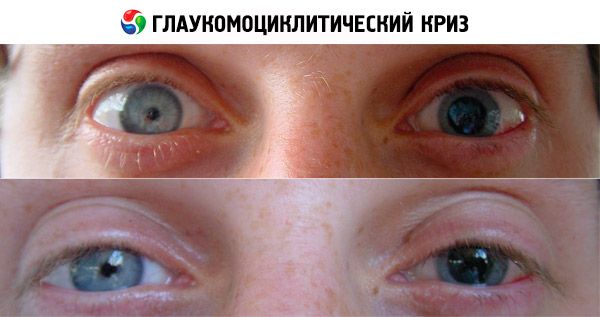Medical expert of the article
New publications
Glaucomocyclitic crisis (Posner-Schlossman syndrome)
Last reviewed: 04.07.2025

All iLive content is medically reviewed or fact checked to ensure as much factual accuracy as possible.
We have strict sourcing guidelines and only link to reputable media sites, academic research institutions and, whenever possible, medically peer reviewed studies. Note that the numbers in parentheses ([1], [2], etc.) are clickable links to these studies.
If you feel that any of our content is inaccurate, out-of-date, or otherwise questionable, please select it and press Ctrl + Enter.
Glaucomatocyclitic crisis is a syndrome characterized by repeated episodes of mild idiopathic unilateral nongranulomatous anterior uveitis in combination with a marked increase in intraocular pressure.
The syndrome was first described in 1929, but it was named after Posner and Schlossman, who described the syndrome in 1948.
 [ 1 ]
[ 1 ]
Epidemiology
Glaucomatocyclitic crisis is usually diagnosed in patients aged 20-50 years. In the vast majority of cases, the process is unilateral, although cases of bilateral involvement have been described.
Causes glaucomocyclitic crisis
The cause of glaucomatocictic crisis is unknown. It is believed that the increase in intraocular pressure occurs as a result of a sharp disruption of the outflow of intraocular fluid during an exacerbation. It has been shown that prostaglandins play a certain role in the pathogenesis of this disease, since their concentration in the intraocular fluid correlates with the level of intraocular pressure during an attack. Prostaglandins disrupt the "blood-aqueous humor" barrier, as a result of which proteins and inflammatory cells enter the intraocular fluid, its outflow is disrupted, and intraocular pressure increases. Some patients with glaucomatocictic crisis experience a disruption in the dynamics of intraocular fluid between episodes of the disease, sometimes background primary open-angle glaucoma.
Symptoms glaucomocyclitic crisis
These patients have a history of recurrent episodes of mild ocular pain or discomfort and blurred vision without evidence of vascular injection. Some patients also complain of rainbow-like halos around lights, suggesting corneal edema.

Course of the disease
Posner-Schlossman syndrome is a self-limited ocular hypertension that resolves spontaneously regardless of treatment. Inflammatory attacks recur at intervals of months to years, lasting from hours to weeks before spontaneous resolution. Optic nerve damage and visual field defects in glaucomatous cyclitis may occur as a result of repeated episodes of marked intraocular pressure elevation in the presence of primary open-angle glaucoma.
Diagnostics glaucomocyclitic crisis
External ophthalmologic examination often reveals no abnormalities. Examination of the anterior segment usually reveals several precipitates on the endothelium of the inferior cornea. In some cases, especially with sufficiently elevated intraocular pressure, corneal edema in the form of microcysts may be observed. Sometimes corneal precipitates are detected by gonioscopy, indicating the presence of trabeculitis. The anterior chamber fluid usually contains a small number of inflammatory cells and is slightly opalescent. With significant increases in intraocular pressure, a slight dilation of the pupil may be observed, but peripheral anterior and posterior synechiae do not form. Rarely, heterochromia is observed, developing as a result of iris stromal atrophy with repeated unilateral inflammatory attacks. Intraocular pressure is usually significantly higher than expected for such activity of intraocular inflammation, usually exceeding 30 mm Hg. (often 40-60 mm Hg). Changes in the fundus usually do not occur.
Laboratory research
Diagnosis of glaucomatocictic crisis is based on clinical data. There are no laboratory tests to confirm the diagnosis.
Differential diagnosis
Differential diagnosis of glaucomatous cyclitis should be made with Fuchs' heterochromic iridocyclitis, uveitis caused by herpes simplex or herpes zoster, sarcoidosis, HLA B27-associated anterior uveitis, and idiopathic anterior uveitis.
 [ 6 ]
[ 6 ]
Who to contact?
Treatment glaucomocyclitic crisis
Treatment of Posner-Schlossman syndrome begins with topical glucocorticoids to control anterior uveitis. If intraocular pressure does not decrease in response to anti-inflammatory therapy, antiglaucoma drugs should be prescribed. Mydriatic and cycloplegic drugs are usually not required because ciliary muscle spasm is not characteristic of the syndrome and synechiae rarely form.
Oral indomethacin, a prostaglandin antagonist, at a dose of 75-150 mg daily has been shown to reduce intraocular pressure more rapidly in patients with glaucomatous cyclitis than standard antiglaucoma drugs. It is expected that topical nonsteroidal anti-inflammatory drug therapy will be effective in patients with ocular hypertension.
Miotics and argon laser trabeculoplasty are usually ineffective. Preventive anti-inflammatory therapy is not required between attacks. The need for operations aimed at improving filtration is extremely rare, and their implementation does not prevent the development of repeated inflammatory attacks.

